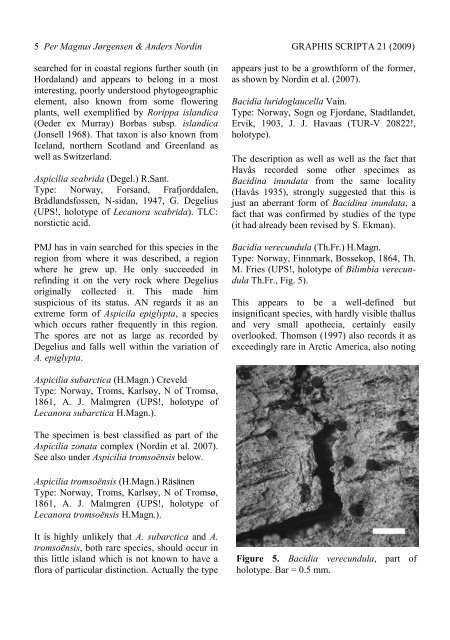(2009): Lichens in Scandinavia known mainly from Norwegian type ...
(2009): Lichens in Scandinavia known mainly from Norwegian type ...
(2009): Lichens in Scandinavia known mainly from Norwegian type ...
You also want an ePaper? Increase the reach of your titles
YUMPU automatically turns print PDFs into web optimized ePapers that Google loves.
5 Per Magnus Jørgensen & Anders Nord<strong>in</strong> GRAPHIS SCRIPTA 21 (<strong>2009</strong>)<br />
searched for <strong>in</strong> coastal regions further south (<strong>in</strong><br />
Hordaland) and appears to belong <strong>in</strong> a most<br />
<strong>in</strong>terest<strong>in</strong>g, poorly understood phytogeographic<br />
element, also <strong>known</strong> <strong>from</strong> some flower<strong>in</strong>g<br />
plants, well exemplified by Rorippa islandica<br />
(Oeder ex Murray) Borbas subsp. islandica<br />
(Jonsell 1968). That taxon is also <strong>known</strong> <strong>from</strong><br />
Iceland, northern Scotland and Greenland as<br />
well as Switzerland.<br />
Aspicilia scabrida (Degel.) R.Sant.<br />
Type: Norway, Forsand, Frafjorddalen,<br />
Brådlandsfossen, N-sidan, 1947, G. Degelius<br />
(UPS!, holo<strong>type</strong> of Lecanora scabrida). TLC:<br />
norstictic acid.<br />
PMJ has <strong>in</strong> va<strong>in</strong> searched for this species <strong>in</strong> the<br />
region <strong>from</strong> where it was described, a region<br />
where he grew up. He only succeeded <strong>in</strong><br />
ref<strong>in</strong>d<strong>in</strong>g it on the very rock where Degelius<br />
orig<strong>in</strong>ally collected it. This made him<br />
suspicious of its status. AN regards it as an<br />
extreme form of Aspicila epiglypta, a species<br />
which occurs rather frequently <strong>in</strong> this region.<br />
The spores are not as large as recorded by<br />
Degelius and falls well with<strong>in</strong> the variation of<br />
A. epiglypta.<br />
Aspicilia subarctica (H.Magn.) Creveld<br />
Type: Norway, Troms, Karlsøy, N of Tromsø,<br />
1861, A. J. Malmgren (UPS!, holo<strong>type</strong> of<br />
Lecanora subarctica H.Magn.).<br />
The specimen is best classified as part of the<br />
Aspicilia zonata complex (Nord<strong>in</strong> et al. 2007).<br />
See also under Aspicilia tromsoënsis below.<br />
Aspicilia tromsoënsis (H.Magn.) Räsänen<br />
Type: Norway, Troms, Karlsøy, N of Tromsø,<br />
1861, A. J. Malmgren (UPS!, holo<strong>type</strong> of<br />
Lecanora tromsoënsis H.Magn.).<br />
It is highly unlikely that A. subarctica and A.<br />
tromsoënsis, both rare species, should occur <strong>in</strong><br />
this little island which is not <strong>known</strong> to have a<br />
flora of particular dist<strong>in</strong>ction. Actually the <strong>type</strong><br />
appears just to be a growthform of the former,<br />
as shown by Nord<strong>in</strong> et al. (2007).<br />
Bacidia luridoglaucella Va<strong>in</strong>.<br />
Type: Norway, Sogn og Fjordane, Stadtlandet,<br />
Ervik, 1903, J. J. Havaas (TUR-V 20822!,<br />
holo<strong>type</strong>).<br />
The description as well as well as the fact that<br />
Havås recorded some other specimes as<br />
Bacid<strong>in</strong>a <strong>in</strong>undata <strong>from</strong> the same locality<br />
(Havås 1935), strongly suggested that this is<br />
just an aberrant form of Bacid<strong>in</strong>a <strong>in</strong>undata, a<br />
fact that was confirmed by studies of the <strong>type</strong><br />
(it had already been revised by S. Ekman).<br />
Bacidia verecundula (Th.Fr.) H.Magn.<br />
Type: Norway, F<strong>in</strong>nmark, Bossekop, 1864, Th.<br />
M. Fries (UPS!, holo<strong>type</strong> of Bilimbia verecundula<br />
Th.Fr., Fig. 5).<br />
This appears to be a well-def<strong>in</strong>ed but<br />
<strong>in</strong>significant species, with hardly visible thallus<br />
and very small apothecia, certa<strong>in</strong>ly easily<br />
overlooked. Thomson (1997) also records it as<br />
exceed<strong>in</strong>gly rare <strong>in</strong> Arctic America, also not<strong>in</strong>g<br />
Figure 5. Bacidia verecundula, part of<br />
holo<strong>type</strong>. Bar = 0.5 mm.

















